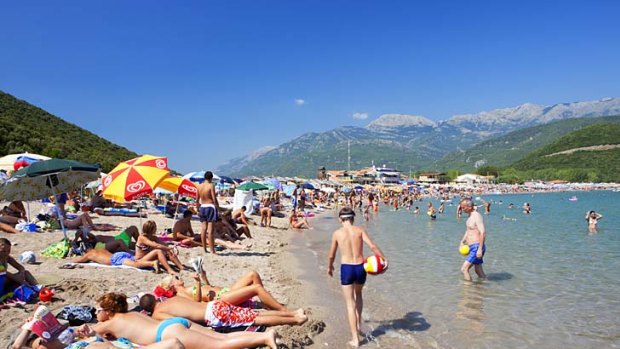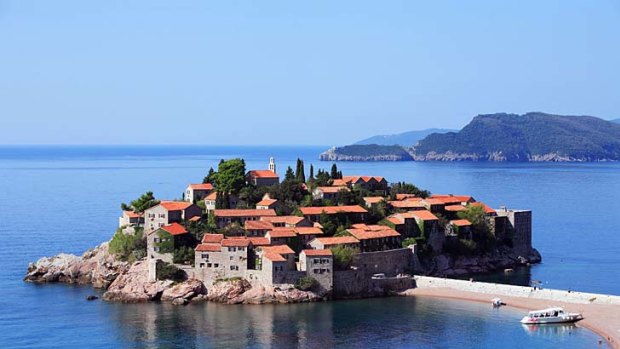This was published 12 years ago
Beautiful and wild: Europe's new 'must do' destination

Budva ... Montenegro is home to some of the best beaches on the Adriatic.Credit: Getty Images
Montenegro is fast becoming Europe's hottest destination. A decade after her first visit, Julia Warren returns to see what awaits.
Has Montenegro's moment come? In recent years it has been hailed as the next "must do" holiday destination, and judging by the ranks of bobbing super-yachts moored at the new Porto Montenegro Marina near the coastal town of Tivat, the beautiful people have got the message. This summer it will be easier for ordinary mortals to reach the country thanks to new, direct flights from London's Gatwick to Tivat. The twice-weekly Montenegro Airlines service will deliver holidaymakers closer to the beach resorts of Budva, Becici, Przno, Sveti Stefan and Petrovac (cutting out the longer drive from Dubrovnik airport in neighbouring Croatia).
Nearly 10 years ago, I used to visit Montenegro regularly to stay with friends who had bought a villa there. I liked the place - and the space. The national parks were spectacular. My friends and I used to picnic on the Lustica peninsula or drive up to Skadar Lake for leisurely afternoons messing about in a boat. It lived up to the tourist board slogan: "Wild beauty."

Instantly recognisable ... Sveti Stefan - the beautiful little islet off the Adriatic just south of Budva, connected to the mainland by a small isthmus.Credit: AFP
Back then, Montenegro was part of what was rather unflatteringly known as the "rump Yugoslavia", a union with Serbia that was all that was left of the old Yugoslav federation. It had a scruffy-dog sort of appeal. But by 2006, Montenegrins, too, went their own way, declaring independence, adopting the euro and turning their attention towards tourism.
My friends moved on and I received reports of overdevelopment: too much concrete and not much style. This seemed a terrible shame, because within an area no bigger than Northern Ireland, Montenegro boasts a rugged, mountainous interior and an indented coastline that, in places, resembles the Norwegian fjords - but with a good deal more sunshine. It also has some of the best beaches on the Adriatic.
The new flights had given me an excuse to return. How would the country look now? Would it be ruined? And would it really be the "must-visit" destination for European holidaymakers? First impressions weren't promising. As I drove towards Budva from Tivat, cranes appeared like creeping ghosts and there were many new apartment blocks, some unfinished and seemingly abandoned. I asked Vesna, my guide, about these eyesores. She grimaced.
"As a result of the recession, the money ran out and the building stopped. Thank goodness! On this stretch of coast, we have enough places for tourists now." I wondered if these half-finished projects would ever be completed.
But then things looked up. My first stop was the sparkling new Porto Montenegro Marina, designed to lure yacht-owners away from the old-world Mediterranean fleshpots of Monte Carlo and Cannes by charging them 30 per cent less in mooring fees. It appears to be working. Even as early as April, the restaurants, bars, spas and shops were buzzing and the marina was full of sleek new craft; 185 berths have already been taken. Vesna told me about the glittering party that took place here last summer, marking the 40th birthday of Nat Rothschild, one of the British investors in Porto Montenegro. Palm trees were imported; Naomi Campbell was among the guests.
Another sign that perhaps this really is Montenegro's moment came at Sveti Stefan - the beautiful little islet off the Adriatic just south of Budva, connected to the mainland by a small isthmus. With its red-roofed buildings and idyllic setting, this is one of the most instantly recognisable attractions in the country, and a place that, even under Tito in the Sixties, was known as a playground for the rich and famous. (This was where Sophia Loren famously taught the chef how to cook spaghetti al dente after she was served an unacceptably overcooked version.)
Now it has taken a further leap forward, reopening last year as an Aman Resort - a new addition to a group specialising in serious luxury in unique locations. Here you can holiday in style surrounded by olive trees and flowering rosemary bushes. On the beach at nearby Przno, I dined at Konoba Langust, one of a row of converted beach houses, and enjoyed seafood risotto followed by grilled sea bass. It was without doubt delicious, but at euros 25 (pounds 20), excluding wine, it cost almost as much as it would have done in a fashionable resort in Italy.
I'd seen enough of the jet-set life and returned to what had always been my favourite place here: the Unesco-listed town of Kotor, a place full of Venetian-inspired architecture and tiny twisting streets of white stone bearing workaday names such as Milk Street and Bread Square. I noticed that several crumbling old palaces had been converted into boutique hotels, tapping into demand for stylish but affordable accommodation in a place of genuine old-world charm. But I did not feel the place had been spoilt. Stepping through the arched entrances to this little walled city you still enter another world; a place where silver-haired men sit alongside younger locals on cafe terraces exchanging tales in a carefree manor. It felt far removed from the beach resorts, the construction sites and the swanky yachts. Slowly but surely in Kotor my love for the simplicity and beauty of the country was rekindled.
On leaving I asked Vesna about that slogan. Which one was true about Montenegro: wild or beauty? "Both," she beamed.
Getting there
Montenegro Airlines (www.montenegroairlines.com) offers return flights between London and Tivat from about $A310.
Further information
- The Telegraph, London
Sign up for the Traveller Deals newsletter
Get exclusive travel deals delivered straight to your inbox. Sign up now.